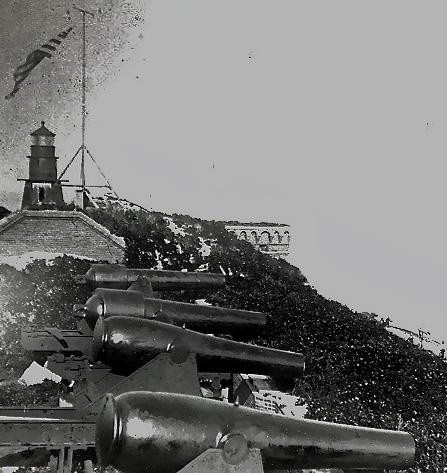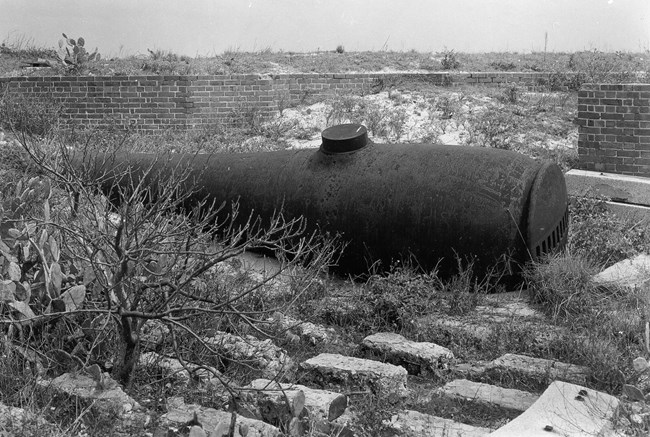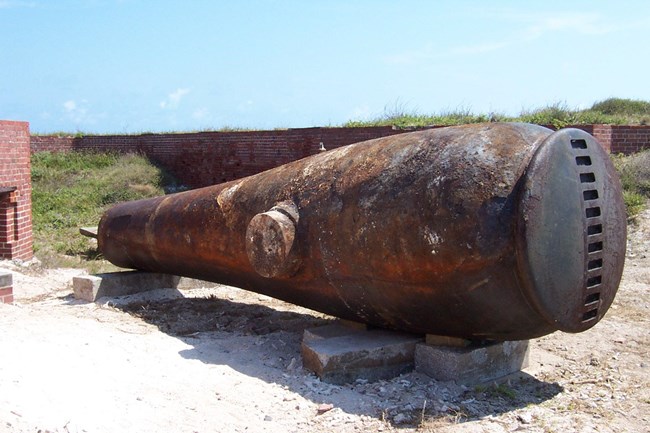Contributors: Ronald Harvey: Tuckerbrook Conservation LLC; Jonathan Taggart: Taggart Objects Conservation; Nancy Russell: National Park Service, Dry Tortugas National Park

NPS Photo
Historical Background
Construction of Fort Jefferson began in 1846 and continued for thirty years. The location was chosen for its deep harbor and to protect key shipping lanes in the Straits of Florida and the Gulf of Mexico. The fort remained in Union hands during the Civil War and was used as a prison. In 1872-1873, one 15-inch smoothbore Rodman gun was mounted at each of the fort’s six bastions and four 300-pounder rifled Parrott guns were mounted on three fronts.
The U.S. Army garrison left Fort Jefferson in 1874. In 1900 the War Department sold the ordnance stores, including the cannon, carriages, ammunition, and associated equipment, to Henry A. Hitner’s Sons, an iron and steel scrap dealer from Philadelphia, for $14,054.20. By 1913, only the largest Rodman and Parrott guns remained. Removing these ten guns appeared to be more trouble than they were worth. The iron carriages were salvaged and the large guns were left behind.

NPS Photo (DRTO 300573)
Project Location
Fort Jefferson is located on Garden Key, one of seven small islands within Dry Tortugas National Park. The 100-square-mile park is located about 68 miles west of Key West, Florida, and is accessible only by boat or seaplane. Surrounded by a moat, the fort entrance is by a small sally port. Twelve National Park Service (NPS) employees live at Fort Jefferson year round. Electricity is provided by three diesel generators and drinking water is created through reverse-osmosis treatment of rainwater. All food, materials, supplies, and equipment must be brought to and from the park by the NPS supply boat. In 2014, the park received 64,865 visitors.

NPS Photo (EVER 7128)
Nationally Significant Collection
The park’s museum collection includes six of the twenty-five 15-inch Rodman guns known to survive in the United States, and four of the thirteen surviving 300-pounder Parrott guns. With most guns going to World War II scrap metal drives, the Fort Jefferson guns represent about 25% of the existing guns of each size. These Parrott guns were manufactured at the West Point Foundry in 1864-1865 and the Rodman guns were cast in Boston in 1871.

NPS Photo
Conservation Challenges
Logistical and professional challenges that had to be addressed in the proposed treatments included:
- Remote location of the national park.
- Design limitations of the historic fort.
- Working in a national park with its sensitive cultural and natural resources.
- Limited NPS infrastructure, utilities, and staffing on site.
- Heat, humidity, rain, storms, and hurricane season.
- Location of the guns on the terreplein of Fort Jefferson (c. 45 feet above parade ground).
- Size and weight of the objects (c. 25-ton Rodman and c. 11-ton rifled Parrott guns).
- Condition of the guns, which exhibited extensive corrosion.
- Ability to retreat in the future.
- Sustainability of the treatment in the harsh marine climate.

Treatment sustainability of Rodman guns
Last updated: July 16, 2024
